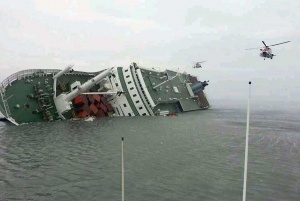Sinking of MV Sewol
 | |
| Date | 09:00, 16 April 2014 - 11:30, 16 April 2014 |
|---|---|
| Location | 1.5 kilometres (0.93 mi) off, Donggeochado, Jindo County, South Jeolla Province, South Korea |
| Deaths | 295 |
| Survivors | 172 |
| Description | A ferry sinking which killed hundreds of schoolchildren. Officially, an accident, but information hidden and falsified in investigation. |
The MV Sewol was a South Korean vehicle-passenger ferry, which operated between Incheon and Jeju. On 16 April 2014, Sewol capsized and sank. Out of 476 passengers and crew, 304 died in the disaster, including around 250 students from Danwon High School.
Official narrative
A combination of factors combined to create this a tragic accident in broad daylight in calm waters.
Documentary
The documentary film Intention (2018) by Kim Ji-young carefully analyzes the sinking, focusing on the “why” but not the “who”. The film traces back the Sewol's voyage from April 15, when it left port, to the day it sank. After a long search, the documentary found a bizarre track data of the vessel before its sinking.
It took the director about three and a half years to complete the movie as he had to collect and analyze a massive amount of the AIS raw data from the South Korean Coast Guard and radar logs from the Navy, before cross-checking the objective data with testimonies from survivors.[1][2]
The AIS is like a car black box offering a real-time information on the car's speed and location, but the AIS is shared by other ships and the maritime authorities to avoid collision and control traffic at sea.
The passenger ship repeated sharp turns when it sailed near small islands in the West Sea scattered with a number of islets. When it passed very close to the last islet before its sinking, the vessel made a left turn that is not physically possible in the real world, and the film shows how the AIS data was falsified and how data disappeared.